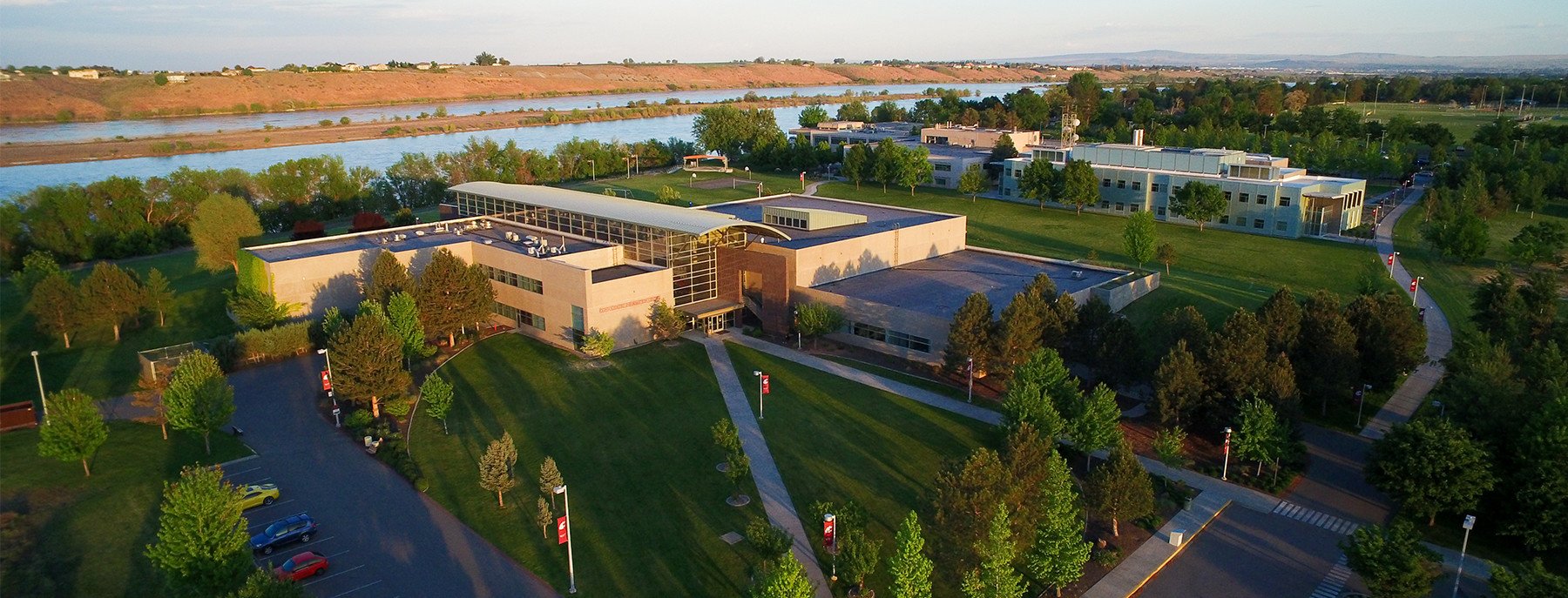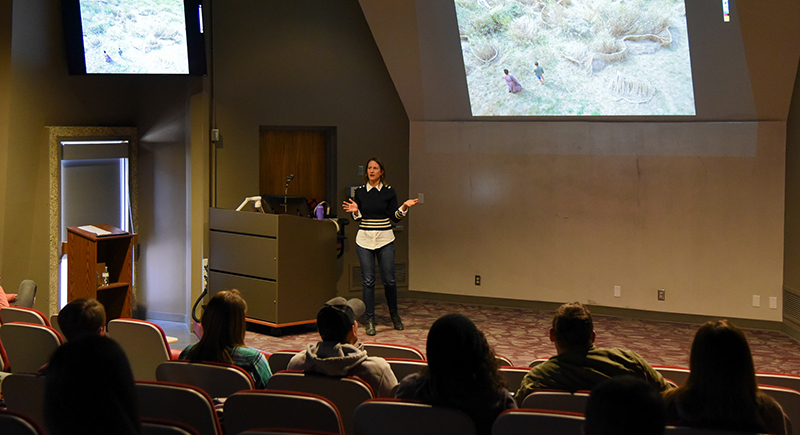
December 22, 2017 Residency program provides community with in-depth look at creative professions
By Maegan Murray
During the couple of weeks that artist and urban planner Sarah Kavage was at Washington State University Tri-Cities this fall, she had quite the busy schedule.
She met with students about her life as an artist and urban planner, provided an in-depth and hands-on look at her works and presented about her efforts in improving communities by introducing art and culture.
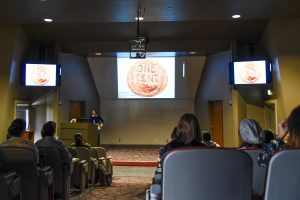
Artist Sarah Kavage presents to students about an art project she completed in recent years involving the uses of thousands of pounds of flour she had purchased and the discussions she was able to bring about on access to food and other related areas through the project.
But in addition to what she was able to bring to the students and community of the Tri-Cities through her artistic experience, she also had the opportunity to gain some cultural knowledge of the area and explore possible future art installations as part of her own professional repertoire.
Kavage’s visit was part of the new Cultural Capital Residency Program at WSU Tri-Cities, which is the brain child of Peter Christenson, artist and WSU Tri-Cities fine arts and digital technology and culture professor.
An enhanced scholastic experience
Christenson said his goal with the residency program, which kicked off this fall, is to introduce artists and other scholars to the Tri-Cities community with the goal of expanding upon traditional learning opportunities typically held in a university setting. Through the program, scholars with backgrounds ranging from the arts, to engineering, to urban planning, to social work, temporarily live in a living learning community among WSU Tri-Cities students, which is located adjacent to campus.
At the living learning community, the scholars participate in community dinners, discussion sessions and generally interact with the students in the living learning communities. Additionally, the scholars hold open informational office hours at WSU Tri-Cities where they welcome interaction with students on campus, complete art and other creative projects with classes at WSU Tri-Cities, present guest lectures to the students and Tri-Cities community, in addition to using the experience as a means to explore and learn more about the Tri-Cities.
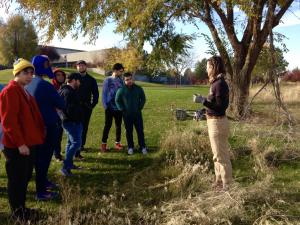
Visiting scholar Sarah Kavage talks to students about an eco-art project she completed. The students then had the chance to try out some of the techniques for the project, themselves.
“With the Cultural Capital Scholar Residency program, we wanted to enhance the educational model,” Christenson said. “We want to give exposure to a variety of research agendas and forms of scholarship. Through this program, we get to pick from an international scope of scholars. This way, students get access to a broad range of scholarship.”
Giving back, giving forward
Kavage marked the second scholar to participate in the residency program at WSU Tri-Cities. Her work centers around place, history and ecology. The first scholar was multimedia artist and communicator Laurel Terlesky, whose work examines the use of technology to communicate and build relationships.
Kavage said she had participated in residency programs prior to completing her experience at WSU Tri-Cities, but that this was the first time she had the opportunity to have in-depth interactions with university students.
“It is always wonderful to have people to pass your knowledge on to who are interested in sharing and learning about your work,” she said. “I appreciated the dialogue that we had. Some of what I did in Allison Matthews’ environmental psychology class was asking students about their perceptions of this area, given its history with Hanford. I also had the opportunity to work with students on an eco-art project. It’s been an awesome experience.”
Kavage said one of the things that drew her to the residency program at WSU Tri-Cities was the Tri-Cities’ cultural and historical ties to the Hanford Site.
“Being here and doing the tours of the B Reactor and Hanford site has given me a much better insight into this area,” she said. “There is a lot here. It is a really complex place with a lot of big history. It provides great opportunity, artistically.”
As part of the residency experience at WSU Tri-Cities, every scholar is required to submit an art piece or other works back to the university that becomes part of a collection hosted by WSU Tri-Cities. The piece can consist of something they created while they were at WSU, or it could consist of something they had created, prior. Kavage submitted some sketches about possible art installations that could one-day take shape at the Hanford site.
Diversity of scholars and benefit to students
Christenson has a selection of scholars that will participate in the residency program in the coming year. Those individuals include photographer June Tay Sanders, sculptor and multimedia artist Jon Henry, multimedia artist Tra Bouscaren and milliner Jean Hicks.
The variety and diversity of the artists and scholars selected for the program is important, Christenson said, as it encourages diversity of thought, opinion and sharing of ideas among WSU Tri-Cities students and overall Tri-Cities community.
“The students in our community are really diverse,” he said. “Part of a role of a university is to expose our students to a diversity of views, opinions and ideas. Bringing these folks here gives us all an opportunity to think about the world differently, projects differently and our place and community from a different paradigm.”
Student Jessica Roth said the experience of having a visiting scholar, particularly in the arts, proved to be a major benefit to her academic experience at WSU Tri-Cities. She said she enjoys the fact that the artists come to campus, from not only around the country, but from around the world, and that it adds diversity to their studies.
“This exchange of ideas and exposure to different types of successful working artists and their practice is a huge benefit to students because it helps them navigate their own career paths by exploring many creative professional options,” Roth said.
“The diversity in the resident artists, their works and the creative paths that their careers took helps to expand the artistic perspective of our students and lend insight into the endless ways an artist’s work can be culturally informed, unique and successful,” she said.
For more information on the Cultural Capital Scholar Residency Program at WSU Tri-Cities, contact Christenson at peter.christenson@wsu.edu.




